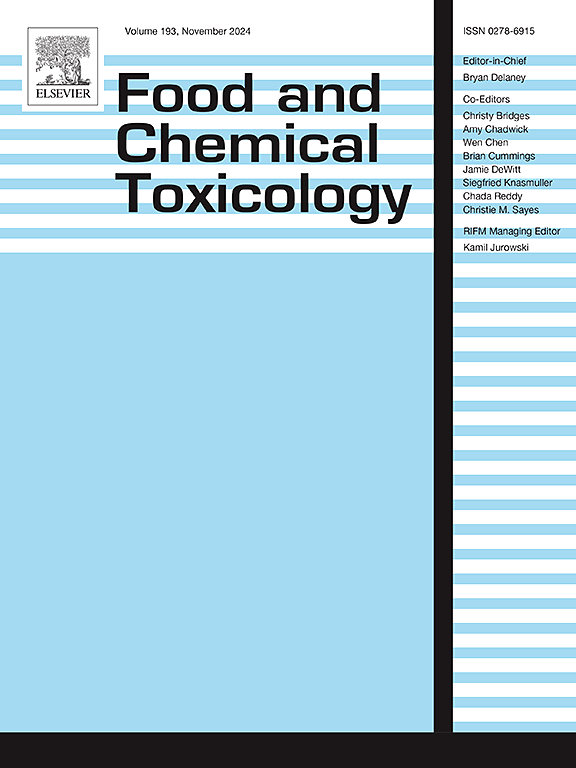Detection of toxicity induced by acrylonitrile exposure in rats and the protective role of astaxanthin using neurotransmitters in predicting 8-hydroxy-2′-deoxyguanosine and protein carbonyl levels
IF 3.9
3区 医学
Q2 FOOD SCIENCE & TECHNOLOGY
引用次数: 0
Abstract
Background
Neurotransmitters could be used as excellent predictors for oxidative stress products assessment. Acrylonitrile (ACN) is a common material used in the industry for the production of plastics, synthetic rubber, resins, fibers, adhesives, and chemical intermediates. However, it may affect the nervous system, neurotransmitter disruption, organs toxicity, protein and DNA damage through propagation of oxidative stress.
Objective
This study aimed to provide equations for predicting the levels of oxidative stress products resulting from acrylonitrile exposure as a model of oxidation reaction stimulation in rats. In addition, astaxanthin (ASTX) protective potential against acrylonitrile toxicity is evaluated.
Methods
Fifty rats were divided equally into five groups according to experimental design. Brain neurotransmitters, LDH, antioxidants, and oxidative stress markers were assessed. Furthermore, multiple regression analysis was used to design the desired equations.
Results
Multiple regression analysis was employed to develop predictive equations for oxidative stress markers based on neurotransmitter levels and lactate dehydrogenase activity. The generated models demonstrated a significant relationship between oxidative damage indicators and key biochemical parameters. The predictive equations were as follows: 8OHdG = 333.77 - 159.21 × DOP + 0.07 × LDH, PC = 6.88–6.98 × NE + 0.002 × LDH, and MDA = 76.86 - 38.67 × DOP + 0.009 × LDH. These equations provide a novel approach for estimating oxidative stress levels. Additionally, there was an improvement in neurotransmitters levels by using ASTX. Also, there was an extreme increase in total antioxidant capacity (TAC) and a significant decrease in cells biological macromolecules damage.
Conclusion
The regression analysis showed that LDH, dopamine, and norepinephrine are good predictors for the concentration of oxidative products of biological macromolecules, including 8-hydroxy-2′-deoxyguanosine (8-OHdG) as a marker of DNA oxidation, protein carbonyl (PC) as a marker of protein oxidation, and malondialdehyde (MDA) as a marker of lipid peroxidation. Moreover, ASTX could efficiently ameliorate acrylonitrile toxicity.
丙烯腈对大鼠毒性的检测及虾青素在神经递质预测8-羟基-2′-脱氧鸟苷和蛋白羰基水平中的保护作用
背景:神经递质可以作为氧化应激产物评估的良好预测因子。丙烯腈(ACN)是工业上用于生产塑料、合成橡胶、树脂、纤维、粘合剂和化学中间体的常用材料。然而,它可能通过氧化应激的传播影响神经系统,神经递质破坏,器官毒性,蛋白质和DNA损伤。目的:本研究旨在为丙烯腈暴露作为氧化反应刺激模型的大鼠提供预测氧化应激产物水平的方程。方法:将50只大鼠按实验设计分为5组。评估脑神经递质、LDH、抗氧化剂和氧化应激标志物。结果:采用多元回归分析建立了基于神经递质水平和乳酸脱氢酶活性的氧化应激标志物预测方程。生成的模型显示氧化损伤指标与关键生化参数之间存在显著关系。预测方程为:8OHdG = 333.77 ~ 159.21 × DOP + 0.07 × LDH, PC = 6.88 ~ 6.98 × NE + 0.002 × LDH, MDA = 76.86 ~ 38.67 × DOP + 0.009 × LDH。这些方程为估计氧化应激水平提供了一种新的方法。此外,使用ASTX可以改善神经递质水平。总抗氧化能力(TAC)显著提高,细胞生物大分子损伤显著降低。结论:回归分析表明LDH、多巴胺和去甲肾上腺素是生物大分子氧化产物浓度的良好预测因子,其中8-羟基-2′-脱氧鸟苷(8-OHdG)是DNA氧化的标记物,蛋白羰基(PC)是蛋白质氧化的标记物,丙二醛(MDA)是脂质过氧化的标记物。此外,ASTX能有效改善丙烯腈毒性。
本文章由计算机程序翻译,如有差异,请以英文原文为准。
求助全文
约1分钟内获得全文
求助全文
来源期刊

Food and Chemical Toxicology
工程技术-毒理学
CiteScore
10.90
自引率
4.70%
发文量
651
审稿时长
31 days
期刊介绍:
Food and Chemical Toxicology (FCT), an internationally renowned journal, that publishes original research articles and reviews on toxic effects, in animals and humans, of natural or synthetic chemicals occurring in the human environment with particular emphasis on food, drugs, and chemicals, including agricultural and industrial safety, and consumer product safety. Areas such as safety evaluation of novel foods and ingredients, biotechnologically-derived products, and nanomaterials are included in the scope of the journal. FCT also encourages submission of papers on inter-relationships between nutrition and toxicology and on in vitro techniques, particularly those fostering the 3 Rs.
The principal aim of the journal is to publish high impact, scholarly work and to serve as a multidisciplinary forum for research in toxicology. Papers submitted will be judged on the basis of scientific originality and contribution to the field, quality and subject matter. Studies should address at least one of the following:
-Adverse physiological/biochemical, or pathological changes induced by specific defined substances
-New techniques for assessing potential toxicity, including molecular biology
-Mechanisms underlying toxic phenomena
-Toxicological examinations of specific chemicals or consumer products, both those showing adverse effects and those demonstrating safety, that meet current standards of scientific acceptability.
Authors must clearly and briefly identify what novel toxic effect (s) or toxic mechanism (s) of the chemical are being reported and what their significance is in the abstract. Furthermore, sufficient doses should be included in order to provide information on NOAEL/LOAEL values.
 求助内容:
求助内容: 应助结果提醒方式:
应助结果提醒方式:


